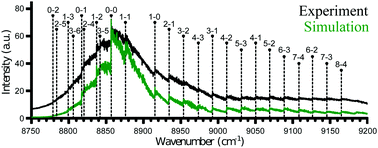Abstract
We report on spectroscopic studies of hot and ultracold RbSr molecules, and combine the results in an analysis that allows us to fit a potential energy curve (PEC) for the X(1)2Σ+ ground state bridging the short-to-long-range domains. The ultracold RbSr molecules are created in a μK sample of Rb and Sr atoms and probed by two-colour photoassociation spectroscopy. The data yield the long-range dispersion coefficients C6 and C8, along with the total number of supported bound levels. The hot RbSr molecules are created in a 1000 K gas mixture of Rb and Sr in a heat-pipe oven and probed by thermoluminescence and laser-induced fluorescence spectroscopy. We compare the hot molecule data with spectra we simulated using previously published PECs determined by three different ab initio theoretical methods. We identify several band heads corresponding to radiative decay from the B(2)2Σ+ state to the deepest bound levels of X(1)2Σ+. We determine a mass-scaled high-precision model for X(1)2Σ+ by fitting all data using a single fit procedure. The corresponding PEC is consistent with all data, thus spanning short-to-long internuclear distances and bridging an energy gap of about 75% of the potential well depth, still uncharted by any experiment. We benchmark previous ab initio PECs against our results, and give the PEC fit parameters for both X(1)2Σ+ and B(2)2Σ+ states. As first outcomes of our analysis, we calculate the s-wave scattering properties for all stable isotopic combinations and corroborate the locations of Fano–Feshbach resonances between alkali Rb and closed-shell Sr atoms recently observed [V. Barbé et al., Nat. Phys., 2018, 14, 881]. These results and more generally our strategy should greatly contribute to the generation of ultracold alkali–alkaline-earth dimers, whose applications range from quantum simulation to state-controlled quantum chemistry.

- This article is part of the themed collection: 2018 PCCP HOT Articles


 Please wait while we load your content...
Please wait while we load your content...